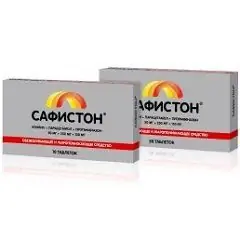- Author Rachel Wainwright [email protected].
- Public 2023-12-15 07:39.
- Last modified 2025-11-02 20:14.
Safiston
Safiston: instructions for use and reviews
- 1. Release form and composition
- 2. Pharmacological properties
- 3. Indications for use
- 4. Contraindications
- 5. Method of application and dosage
- 6. Side effects
- 7. Overdose
- 8. Special instructions
- 9. Application during pregnancy and lactation
- 10. Use in childhood
- 11. In case of impaired renal function
- 12. For violations of liver function
- 13. Use in the elderly
- 14. Drug interactions
- 15. Analogs
- 16. Terms and conditions of storage
- 17. Terms of dispensing from pharmacies
- 18. Reviews
- 19. Price in pharmacies
Latin name: Safiston
ATX code: N02BE71
Active ingredient: caffeine (Caffeine) + paracetamol (Paracetamol) + propyphenazone (Propyphenazone)
Producer: OZON LLC (Russia)
Description and photo update: 2019-10-07
Prices in pharmacies: from 114 rubles.
Buy

Safiston is a combined analgesic non-narcotic drug.
Release form and composition
Dosage form of the drug - tablets: flat-cylindrical, round, with a line on one side and a chamfer on both sides, from white to white with a beige tint, with a slight marbling on the surface (10 pcs. In a blister strip made of aluminum foil and polyvinyl chloride film, in a cardboard box 1-6 or 10 blisters, 10, 20, 30, 40, 50, 60 or 100 pieces in a polymer can, in a cardboard box of 1 can. Each pack also contains instructions for the use of Safiston).
1 tablet contains:
- active ingredients: caffeine - 50 mg, paracetamol - 250 mg, propyphenazone - 150 mg;
- additional components: croscarmellose sodium, povidone (polyvinylpyrrolidone), sodium carboxymethyl starch, colloidal silicon dioxide, microcrystalline cellulose, magnesium stearate.
Pharmacological properties
Pharmacodynamics
Safiston is a combined drug, the effect of which is due to its active ingredients. The combined use of the three main components provides a mutual enhancement of their pharmacological action.
Propyphenazone and paracetamol have analgesic and antipyretic properties.
Paracetamol, being a non-narcotic analgesic, inhibits the enzyme cyclooxygenase (COX) only in the central nervous system (CNS), acting on the centers of thermoregulation and pain (cellular peroxidases in inflamed tissues neutralize the effect of the substance on COX), which leads to an almost complete absence of anti-inflammatory effect … As a result of the lack of influence in peripheral tissues on the production of prostaglandins (PG), paracetamol does not have a negative effect on the mucous membrane of the gastrointestinal tract (GIT) and water-salt metabolism (water and sodium retention).
Propyphenazone is a pyrazolone derivative. The mechanism of action of this component is carried out by suppressing COX, which is involved in the production of GHG from arachidonic acid.
Caffeine enhances the reflex excitability of the spinal cord, stimulates the respiratory and vasomotor centers, dilates the blood vessels of skeletal muscles, heart, brain and kidneys. The active substance reduces platelet aggregation, helps to eliminate drowsiness and fatigue. In the composition of Safiston, caffeine is included in a small dose and practically does not show a stimulating effect on the central nervous system, at the same time it participates in the regulation of the vascular tone of the brain and contributes to an increase in the analgesic effect of the remaining active substances of the drug.
Pharmacokinetics
- paracetamol: it has a high absorption and a slight connection with plasma proteins - 15%. Time to reach peak plasma concentration in blood (T Cmax) is 20-30 minutes. Passes through the blood-brain barrier (BBB), in breast milk it is determined in an amount less than 1% of the dose received by a nursing mother. The therapeutically effective concentration of the substance in plasma is achieved when used in doses of 10-15 mg / kg. The metabolic transformation of paracetamol occurs in the liver: most of the substance (80%) is converted by conjugation with sulfuric and glucuronic acids to form inactive metabolites, a smaller part (17%) - by hydroxylation with the formation of inactive metabolites, conjugating with glutathione and forming inactive metabolites. In the case of a lack of glutathione, these metabolites are able to suppress the enzyme systems of hepatocytes and lead to their necrosis. Half-life (T 1/2) can be 2-3 hours, the agent is excreted by the kidneys, including about 3% unchanged;
- propiphenazone: the maximum concentration (C max) in the blood plasma is observed 30 minutes after administration. The agent is metabolized in the liver, its T 1/2 is 1-1.5 hours. When combined with paracetamol, the period of excretion of propiphenazone increases by 40%, which is of great importance, since it allows to reduce the frequency of taking Safiston throughout the day. The substance is eliminated by the kidneys;
- caffeine: T 1/2 is 3.5 hours, T Cmax - 1 hour; The kidneys are excreted from 65 to 80%, mainly in the form of 1-methyl uric acid, 1-methylxatin and acetylated uracil derivatives, a small amount is converted to theobromine and theophylline.
Indications for use
Safiston is recommended for use in relieving pain syndrome of mild / moderate intensity of various origins: migraine, headache, myalgia, arthralgia, toothache, algodismenorrhea.
Also, the drug is indicated for febrile conditions against the background of diseases of an infectious and inflammatory nature (including ARVI and influenza) as an antipyretic agent.
Contraindications
Absolute:
- severe renal and / or hepatic impairment;
- acute hematoporphyria;
- oppression of bone marrow hematopoiesis (anemia, including hemolytic; leukopenia);
- intracranial hypertension;
- conditions leading to respiratory depression;
- acute myocardial infarction;
- arrhythmias, ischemic heart disease;
- arterial hypertension;
- partial or complete combination of bronchial asthma, recurrent polyposis rhinosinusitis and intolerance to non-steroidal anti-inflammatory drugs (including data in the anamnesis);
- deficiency of the enzyme glucose-6-phosphate dehydrogenase;
- peptic ulcer and 12 duodenal ulcer;
- insomnia;
- glaucoma;
- age up to 12 years;
- pregnancy and lactation;
- hypersensitivity to any of the constituents of the drug.
Relative (you should take Safiston tablets with caution):
- epilepsy and a predisposition to seizures;
- benign hyperbilirubinemia (including Dubin-Johnson, Gilbert, Rotor syndromes);
- alcoholism;
- elderly age.
Safiston, instructions for use: method and dosage
Safiston is taken orally. It is advisable to use the tablets 1-2 hours after a meal with plenty of liquid.
The drug is recommended to be taken 1-3 times a day: adolescents 12-18 years old - 1 tablet, adults - 1-2 tablets. The maximum single dose should not exceed 2 tablets, the maximum daily dose should not exceed 6 tablets.
As an anesthetic, Safiston should not be used for more than 5 days, as an antipyretic - for more than 3 days, without the appointment and supervision of the attending physician.
An increase in the daily dose of Safiston or the course of therapy is allowed only under the supervision of a physician. Do not exceed the recommended dose.
Side effects
- hematopoietic system: agranulocytosis, thrombocytopenia, hemolytic anemia;
- Gastrointestinal tract: discomfort and heaviness in the stomach, nausea, vomiting;
- CNS: insomnia, dizziness;
- immune system: pruritus, skin rash, urticaria, Quincke's edema, toxic epidermal necrolysis (Lyell's syndrome), exudative erythema multiforme (including Stevens-Johnson syndrome).
Overdose
Symptoms of paracetamol overdose, manifested after taking it at a dose of 10-15 g, may include the following disorders: decreased appetite, pallor of the skin, pain in the epigastric region, vomiting, nausea, hepatotoxic and nephrotoxic effects. In severe intoxication, an increase in prothrombin time, an increase in the activity of hepatic transaminases, hepatonecrosis, hepatic failure, encephalopathy, and coma are likely.
In this condition, at the initial stage, the stomach is washed and activated charcoal is prescribed. Then, symptomatic therapy is carried out, if necessary, donors of SH-groups and precursors of glutathione synthesis are administered (8-9 hours after the overdose - methionine, after 12 hours - N-acetylcysteine).
Taking high doses of caffeine can lead to the following symptoms: irritability, tremors, headache, agitation, restlessness, ringing in the ears, nausea, vomiting, gastralgia, frequent urination, hyperthermia, confusion, arrhythmia, tachycardia, seizures (in case of acute overdose - tonic-clonic).
To relieve these symptoms, gastric lavage is performed, activated charcoal, laxatives are taken, ventilation of the lungs is maintained and oxygenation is performed. In case of convulsions, phenobarbital, diazepam are prescribed intravenously, and the water-electrolyte balance is maintained.
There is no information on propiphenazone overdose.
special instructions
In the case of prolonged use of Safiston - more than 5 days, it is necessary to monitor the functional state of the liver and the picture of peripheral blood. During the period of therapy, due to the aggravation of the risk of gastrointestinal bleeding, it is necessary to refrain from drinking ethanol-containing drinks.
While taking Safiston, excessive consumption of products containing caffeine, such as coffee and tea, can trigger the development of overdose symptoms.
In acute abdominal pain, drug therapy can make it difficult to accurately diagnose.
Influence on the ability to drive vehicles and complex mechanisms
When taking Safiston, you should be very careful to drive vehicles and engage in other activities that require increased concentration of attention and quick reactions.
Application during pregnancy and lactation
The use of Safiston tablets during pregnancy and lactation is contraindicated.
Pediatric use
The use of Safiston is contraindicated in children under 12 years of age.
With impaired renal function
Safiston is contraindicated in patients with severe renal impairment.
For violations of liver function
Safiston is contraindicated in patients with severe hepatic impairment.
Use in the elderly
In elderly people, paracetamol clearance decreases, and T 1/2 increases. When treating patients of this age group, Safiston must be used with caution.
Drug interactions
- antidepressants, anticholinergics, cholestyramine, alkaline substances: reduce the effectiveness of Safiston;
- anticonvulsants, barbiturates, ethanol: there is a significant increase in the hepatotoxic effect of therapy;
- chloramphenicol: T 1/2 of this drug increases 5 times when taken in combination with paracetamol;
- metoclopramide: accelerates the absorption of paracetamol;
- myelotoxic drugs: there is an aggravation of the manifestations of paracetamol hematotoxicity;
- anticoagulants: the effectiveness of these drugs increases under the action of paracetamol, used in high doses;
- beta-blockers: mutual suppression of therapeutic effects is possible when combined with caffeine;
- beta-adrenomimetics: additional stimulation of the central nervous system and other toxic effects can be recorded when used simultaneously with caffeine;
- ergotamine: its absorption is accelerated;
- calcium preparations: the absorption of these funds is weakened;
- narcotic and hypnotics: the effect of these drugs decreases when combined with caffeine;
- cardiac glycosides: the absorption of these drugs is accelerated and their effect is enhanced, and toxicity is aggravated when combined with caffeine;
- lithium preparations: the excretion of these funds from the body is enhanced;
- theophylline and, presumably, other xanthines: their clearance decreases and the risk of the appearance of additive toxic effects in combination therapy with caffeine increases;
- selegiline, furazolidone, monoamine oxidase inhibitors, procarbazine: the threat of developing dangerous cardiac arrhythmias or a significant increase in blood pressure when combined with caffeine in large doses increases;
- adenosine: caffeine is an antagonist of this substance;
- nicotine: increases the rate of caffeine excretion;
- sulfa drugs, oral lipid-lowering drugs, anticoagulants: the effect of these drugs is enhanced when combined with propyphenazone;
- glucocorticosteroids: the ulcerogenic effect is enhanced;
- potassium-sparing diuretics: the effect of these drugs is weakened under the influence of propyphenazone.
Analogs
The analogues of Safiston are: Novalgin, Fluomp Ekstratab, Tempalgin Trio, Kaffetin LIGHT, Saridon, Kaffetin SK, etc.
Terms and conditions of storage
Store in a place protected from light, out of reach of children, at a temperature not exceeding 25 ° C.
The shelf life is 3 years.
Terms of dispensing from pharmacies
Available without a prescription.
Reviews about Safiston
The reviews about Safiston found on specialized sites are mostly positive. Patients note that this drug demonstrates a good result in relieving pain syndrome of moderate intensity of various origins. The drug effectively eliminates headaches and toothaches, pain in muscles and joints, helps with painful menstruation, and also reduces the temperature in feverish conditions against the background of ARVI.
The disadvantages of Safiston are most often indicated by a large number of contraindications and the presence of side effects.
The price of Safiston in pharmacies
Price for Safiston, tablets 50 mg + 250 mg + 150 mg, per pack containing 20 pcs. can be 140-200 rubles.
Safiston: prices in online pharmacies
|
Drug name Price Pharmacy |
|
Safiston tablets 10 pcs. 114 RUB Buy |
|
Safiston tablets 20 pcs. RUB 128 Buy |
|
Safiston tablets 50mg + 250mg + 150mg 10pcs 148 RUB Buy |
|
Safiston tablets 20 pcs. 157 r Buy |

Maria Kulkes Medical journalist About the author
Education: First Moscow State Medical University named after I. M. Sechenov, specialty "General Medicine".
Information about the drug is generalized, provided for informational purposes only and does not replace the official instructions. Self-medication is hazardous to health!






